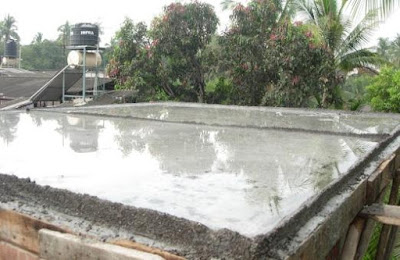In concrete construction,
the importance of curing cannot be over-emphasized. Concrete which is not
adequately cured and loaded before it attains full strength is very likely to
develop cracks. The cracks in concrete adversely affect its durability by corrosion
of reinforcement.
IS 456-2000 (plain and
reinforced concrete – code of practice) defines curing as “the process of
preventing the loss of moisture from the concrete while maintaining a
satisfactory temperature regime.” The moisture loss takes place in two
ways. One is by evaporation caused by the heat generated during
hydration of cement. Second is by evaporation aided by atmospheric temperature and
wind. The evaporation caused by wind and atmospheric temperature increases when
the exposed surface area of concrete increases.
In the case of
horizontal surface such as top of flat slabs, moisture loss is
prevented by ponding – making a pond 8 cm to 10 cm deep and keeping it filled
with water. If the surface is sloped or vertical, ponding is not
possible. Such surfaces are covered by a layer of sacking, canvas,
hessian or similar materials and kept constantly wet. IS 456-2000 stipulates
that exposed surfaces shall be kept constantly wet at least for seven days if
ordinary Portland cement is used, and at least for 10 days, where mineral admixtures or blended cement are
used.
IS 456-2000 permits removal
of vertical form-work of column, beams and walls after a lapse of 24 hours of
placing concrete. It also permits removal of formwork from the underside of
slabs after three days if propos (vertical supports) are re-fixed immediately. Removal
of formwork from the underside of slabs exposes the entire surface to
atmosphere and abets moisture loss. This part cannot be kept wet by
ponding or by covering with sacking or
hessian. Spraying of water is also not effective to keep the surface
constantly wet. Thus, removal of formwork conforming to provisions of IS code
makes it virtually impossible to comply with the provision regarding continuous
curing of exposed surfaces for seven or 10 days.
To speed up construction,
the columns above the slab are raised the very next day of casting the
slab. When column raising and shuttering for the upper slab are in
progress, the ponding of the top surface of the slab is
often neglected as it inconveniences the workers engaged in formwork
erection. The ultimate result is inadequate curing adversely
affecting the strength and durability of concrete.
Now-a-days, there is a
craze for shorter cycle time for slab casting. The cycle time is the
interval between casting one slab and the slab immediately above it. A 10-day
cycle time means once the slab at a particular level is cast, the slab
immediately above it will be cast within 10 days. The concrete
attains design strength in 28 days. Within that period, two upper slabs will be
cast if the cycle time is 10 days. Formwork blow the lower slab
will have been removed, because IS code permits removal of vertical support
below the slab (spanning upto 4.5 metre) after a lapse of seven
days. The stipulation that forms shall not be released until the
concrete has achieved a strength of at least twice the stress to which concrete
may be subjected to at the time of removal of formwork is conveniently
overlooked. Thus, a 10-day-old slab, which, in all probability is
not properly cured, carries the weight of the slab immediately above it. It is
also subjected to impact load caused by the vibration of concrete and movement
of trolleys carrying concrete.
For
More...........:

No comments:
Post a Comment